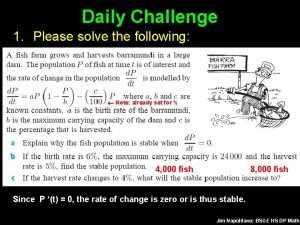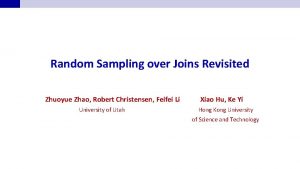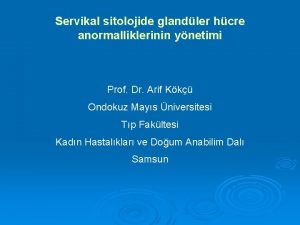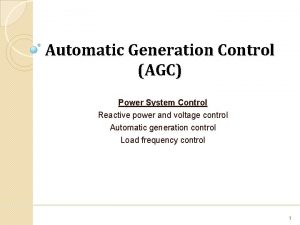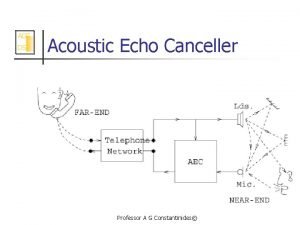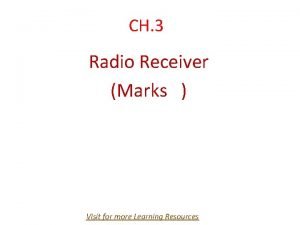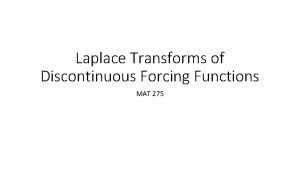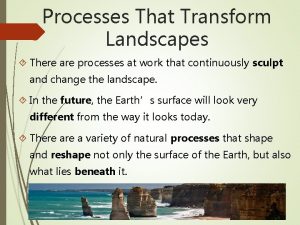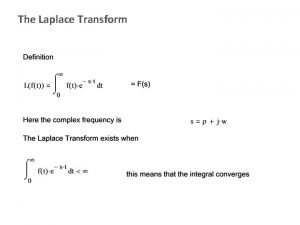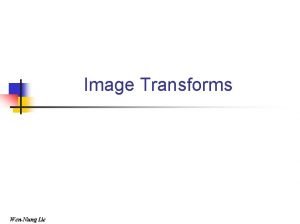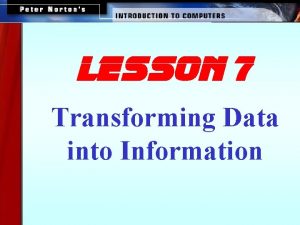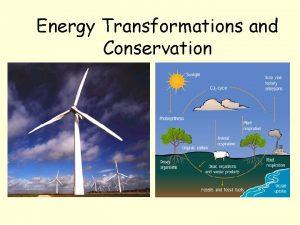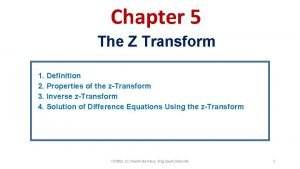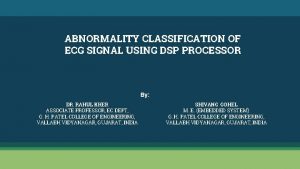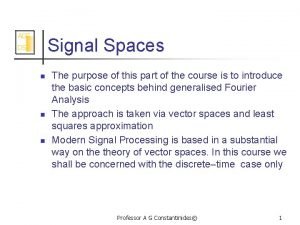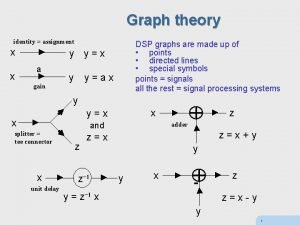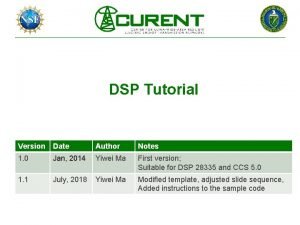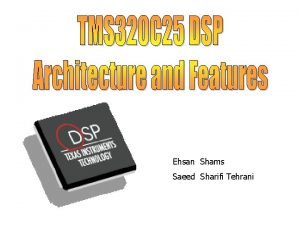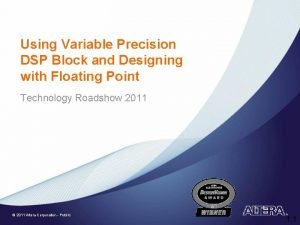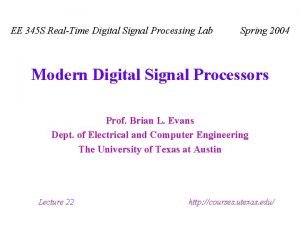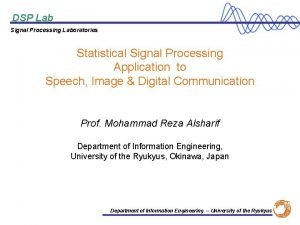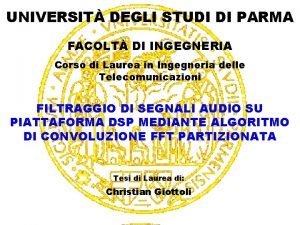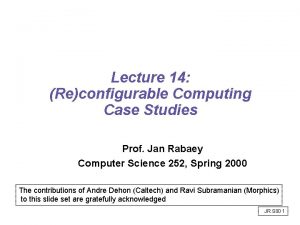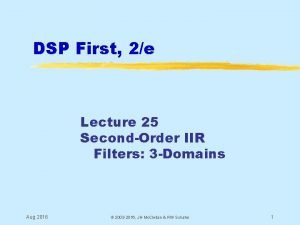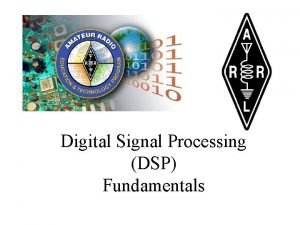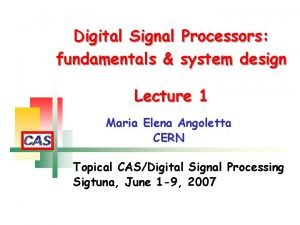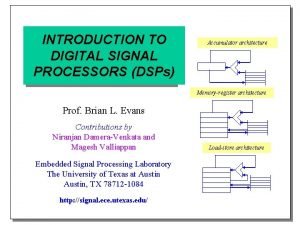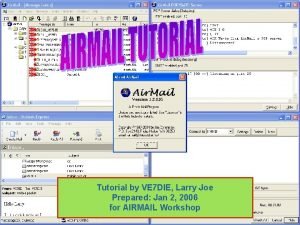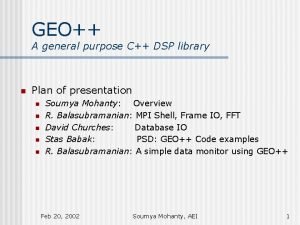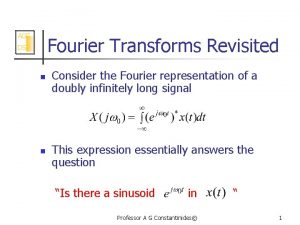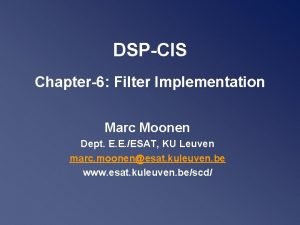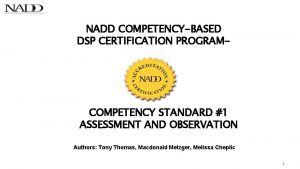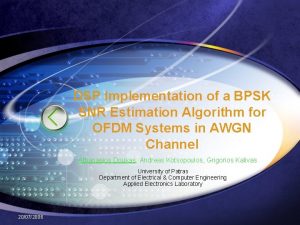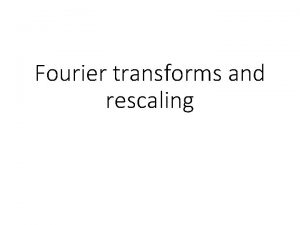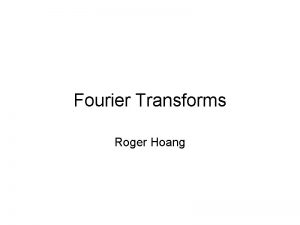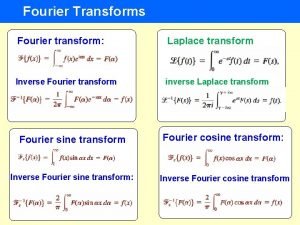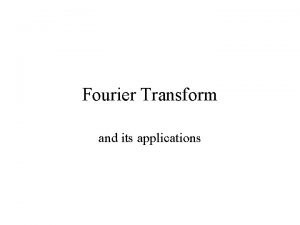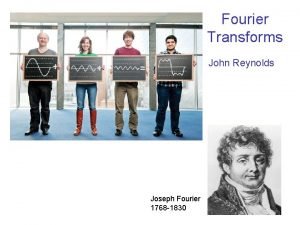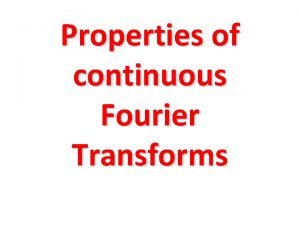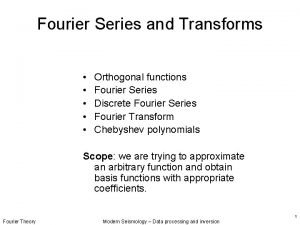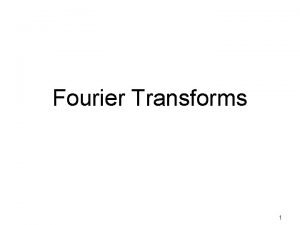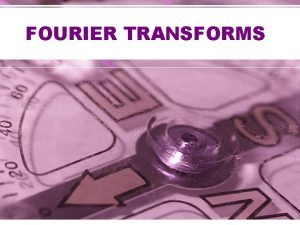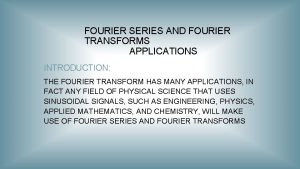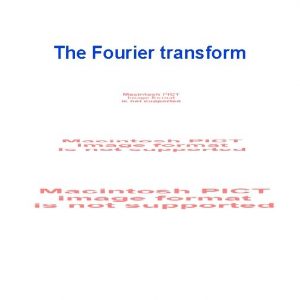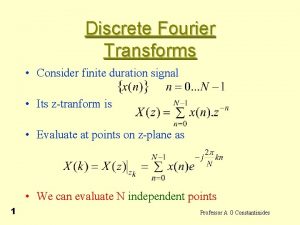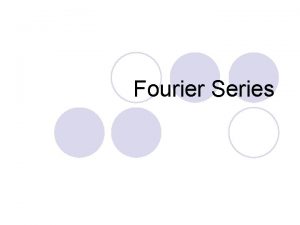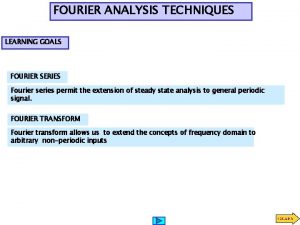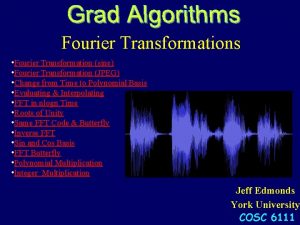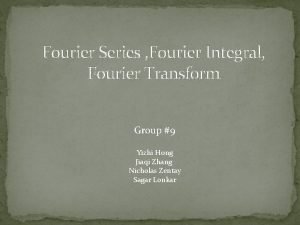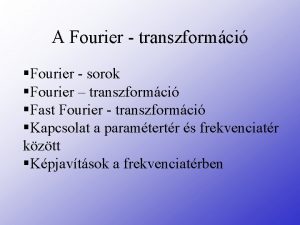AGC Fourier Transforms Revisited DSP n n Consider
























































- Slides: 56

AGC Fourier Transforms Revisited DSP n n Consider the Fourier representation of a doubly infinitely long signal This expression essentially answers the question “Is there a sinusoid in Professor A G Constantinides© “ 1

AGC DSP Fourier Transforms Revisited Also it says “ There is a sinusoid of amplitude in the infinitely long signal “ The implication is that can be written as a “sum” of weighted sinusoids n Hence the inverse form that combines the sinusoids to give the infinite long signal is Professor A G Constantinides© 2

AGC Fourier Transforms Revisited DSP n Sinusoids are n n n orthogonal infinitely long complete deterministic Orthogonality means that a representation of a signal in terms of sinusoidal waveforms leads to a “least squares” problem, i. e. with a finite number of terms we have the best approximation of a given signal in the least square sense. Professor A G Constantinides© 3

AGC Fourier Transforms Revisited DSP n n Orthogonality also means that if we take a finite number of terms in an approximate representation, and we wish to take one more term then the previously calculated weighting coefficients remain unaffected. We need only calculate the weight attached to the additional term Professor A G Constantinides© 4

AGC Fourier Transforms Revisited DSP n n n If we have finite duration signals which we try to represent in terms of infinitely long sinusoids we would expect to have problems. This is because the representation expects the signal to extend to infinity in both directions But it falls to zero outside its support, and at those points there are deviations (Gibbs ripples) Professor A G Constantinides© 5

AGC Fourier Transforms Revisited DSP n n n We can think of the finite duration signal as the product of a top-hat window and an infinitely long signal Thus the spectrum of the infinitely long signal is “smeared” (see your PSD lectures) by the sinc function form of the spectrum of the tophat window. One consequence is that one cannot discern the existence of a “line” in the spectrum of the given signal (see “uncertainty” shortly) Professor A G Constantinides© 6

AGC Fourier Transforms Revisited DSP n n Completeness means that if we take infinite number of terms in our representation then we would get an expression which is “identical” to the given signal Identity in this case means that in the least square sense nothing will be left behind ie the error becomes zero Professor A G Constantinides© 7

AGC Fourier Transforms Revisited DSP n n n Deterministic means that we have an exact value of the signal at every point in time which may be got notionally from a formula Therefore it is not appropriate to use sinusoids, as they are, to represent finite duration stochastic, non-stationary signals (eg real world signals such as speech!) Either some modifications are to be made, or a new framework of representation to be devised Professor A G Constantinides© 8

AGC STFT DSP n n If the given signal is of finite bandwidth (rather than finite duration) then similar observations can be made but now with repect to the time-domain behaviour The Short-Time Fourier Transform is a modification of the normal FT that responds to these needs Professor A G Constantinides© 9

AGC STFT DSP n n n Where is a window shifted to the temporal position of interest Observe that now we have lost orthogonality and possibly completeness of representation The ideas of finite duration and bandwidth may be represented on a time-frequency figure as follows Professor A G Constantinides© 10

AGC Uncertainty DSP n n Principle of Uncertainty in Signals Consider a sinusoidal signal and take a finite segment in time, from –N to +N n Its spectrum is then Professor A G Constantinides© 11

AGC Uncertainty DSP n n n The main lobe is located between the frequencies Or And hence its bandwidth is Professor A G Constantinides© 12

AGC Uncertainty DSP n n It is clear that as the number of terms (i. e. duration of the signal) increases the bandwidth decreases in a reciprocal fashion Thus the frequency of the signal becomes more precisely defined as the signal length tends to infinity. Professor A G Constantinides© 13

AGC Uncertainty n We can represent these ideas on a timefrequency diagram. The ideal case (infinite duration) Infinite duration Zero width n frequency DSP time Professor A G Constantinides© 14

AGC Wavelets The finite bandwidth and duration case finite duration finite width n frequency DSP Professor A G Constantinides© time 15

AGC DSP Wavelets time frequency Professor A G Constantinides© 16

Wavelets 0 0. 2 0. 4 0. 6 n If the DFT is used to analyse a signal the frequency resolution cannot be better than the DFT bin-width With finite length signals the diagram becomes 0. 8 n 1 DSP frequency AGC time Professor A G Constantinides© 17

AGC Wavelets n n Thus if we have a general signal located in the region –N, +N we can “Fourier” (STFT) analyse using DFT. The time-frequency diagram would be Signal duration frequency DSP Signal bandwidth time Professor A G Constantinides© 18

AGC Wavelets DSP n The “Fourier” analysis is now called the Short Time Fourier Transform (STFT) and it essentially asks the following question: “Is there a short period sinusoidal wavefom of frequency in the given signal and where is it located in time? ” n Clearly a filtering interpretation of the STFT is possible Professor A G Constantinides© 19

AGC DSP Degrees of Freedom n Signals bandlimited to and n of finite duration (These quantities need to be defined properly and are related to uncertainty!) n n n Need parameters for the complete description Thus the basic time-frequency rectangle can be divided in any way we desire so long as the total area is covered Professor A G Constantinides© 20

DSP Degrees of Freedom n Possible partitions frequency AGC time Professor A G Constantinides© 21

AGC Gabor Logons n Other partitions are possible (Dennis Gabor, Imperial College 1946) frequency DSP time Professor A G Constantinides© 22

AGC Linear Chirp & FFT DSP n Take a linear chirp and its FFT Professor A G Constantinides© 23

AGC Linear Chirp & STFT DSP n Linear chirp and STFT Professor A G Constantinides© 24

AGC Wavelets DSP n n In a frequency partitioning there is no need to retain all samples per band, as the sampling theorem is satisfied with fewer (in M frequency strips we need retain only 1 in M samples) Hence further partitions are possible Professor A G Constantinides© 25

AGC Wavelets n A typical alternative is (others are possible!) frequency DSP time Professor A G Constantinides© 26

AGC DSP STFT and Wavelets Professor A G Constantinides© 27

AGC STFT and Wavelets DSP New partition recognises the following needs: 1) At high frequencies we would like the time location of events in the signal to be made precise (ie longer data records) 2) while at low frequencies we would like the frequency resolution to be more accurate (ie longer normalised bandwidths) n Professor A G Constantinides© 28

AGC Wavelets DSP n n Contrive to select the new functions over the time-frequency support of each, to be orthogonal The mathematical form of the representation is very similar to the STFT Professor A G Constantinides© 29

AGC Continuous Wavelet Transform DSP § § Compare with the STFT we looked at earlier The similarities are strikingly obvious!!! Professor A G Constantinides© 30

AGC DSP Continuous Wavelet Transform The transformed signal is a function of two variables: n t - translation parameter n a - scale (or dilation) parameter Y (t) is called the mother wavelet Professor A G Constantinides© 31

AGC Continuous Wavelet Transform DSP In a similar way we can think of the above expression as asking the question “ Is there one these functions § in the given signal and where is it located? ”. The expression is a convolution and this leads to a filtering interpretation § Professor A G Constantinides© 32

AGC DSP How to Wavelet Transform Five Easy Steps to a Continuous Wavelet Transform n The continuous wavelet transform is the sum over all time of the signal multiplied by scaled, shifted versions of the wavelet. This process produces wavelet coefficients that are a function of scale and position. n Professor A G Constantinides© 33

AGC DSP How to Wavelet Transform 1 Take a wavelet and compare it to a section at the start of the original signal. Professor A G Constantinides© 34

AGC DSP How to Wavelet Transform 2 Calculate a number, C, that represents how closely correlated the wavelet is with this section of the signal. The higher C is, the more the similarity. Note that the results will depend on the shape of the wavelet you choose. Professor A G Constantinides© 35

AGC DSP How to Wavelet Transform 3 Shift the wavelet to the right and repeat steps 1 and 2 until you’ve covered the whole signal. Professor A G Constantinides© 36

AGC DSP How to Wavelet Transform 4 Scale (stretch) the wavelet and repeat steps 1 through 3. 5 Repeat steps 1 through 4 for all scales. Professor A G Constantinides© 37

AGC DSP Subband Coding Revisited Professor A G Constantinides© 38

AGC DSP Subband Coding Revisited Professor A G Constantinides© 39

AGC DSP Subband Coding Split the signal spectrum with a bank of filters as: Professor A G Constantinides© 40

AGC DSP Subband: Reconstruction Split the signal spectrum with a bank of filters as: Professor A G Constantinides© 41

AGC DSP Subband Coding 1) Arrange for the transfer function of h and for its p-1 first derivatives to vanish at w=p 2) Set 3) This is recognised as the special case of the lowpass to high pass digital filter transformation (Constantinides) for half-band filters 3) Arrange for g and h to be orthogonal 4) Perfect reconstruction conditions are satisfied (Veterli) Professor A G Constantinides© 42

AGC DSP Subband Coding Professor A G Constantinides© 43

AGC DSP Subband Coding Professor A G Constantinides© 44

AGC DSP Sine waves and wavelets Sine wave Wavelet Smooth Non-local (stretch out to infinity) Irregular in shape Compactly supported (contained in finite domains) Professor A G Constantinides© 45

AGC Fourier Transform and DWT DSP n Example: Professor A G Constantinides© 46

AGC DSP Families of wavelets Professor A G Constantinides© 47

AGC DSP Applications of wavelets Some areas of application : 1. Image processing Increasing of quality image, image compression (wavelets are base of MPEG 4) 2. Signal processing : Noise reduction, compression, coding, analysis of non stationary data Other examples of wavelet applications are in astronomy, stock market, medicine, nuclear engineering, neurophysiology, music, optics etc. Professor A G Constantinides© 48

AGC DSP Basic Wavelet Image Coder Input Signal/Image Compressed Signal/Image Source Encoder Quantizer Entropy Encoder There are three basic components in current wavelet coders: §A decorrelating transform. §A quantisation procedure §An entropy coding procedure. Professor A G Constantinides© 49

AGC DSP Image Subband Coding Professor A G Constantinides© 50

AGC DSP Image Subbands LL, LL LH, LL H, L LL, LH LH, LH L, H H, H • The first letter corresponds to horizontal filtering, the last - to vertical • L, H means, for example, that a lowpass is used in the first stage and a highpass in the second Professor A G Constantinides© 51

AGC DSP DWT vs. DCT Original Image Professor A G Constantinides© 52

AGC DSP DWT vs. DCT 98% Wavelet Compression Professor A G Constantinides© 53

AGC DSP DWT vs. DCT 98% DCT Compression Professor A G Constantinides© 54

AGC DSP Residual errors 98% Wavelet Compression 98% DCT Compression Professor A G Constantinides© 55

AGC DSP Denoising §A noisy signal and its reconstruction. A threshold on the Wavelets coefficients has been imposed Professor A G Constantinides© 56
 Math lesson
Math lesson Zhuoyue zhao
Zhuoyue zhao Agv vs agc
Agv vs agc Agc senegal
Agc senegal Thermobel top
Thermobel top Agc nedir tıp
Agc nedir tıp Ascensores registrados empresas conservadoras
Ascensores registrados empresas conservadoras Automatic generation control block diagram
Automatic generation control block diagram Agc blind
Agc blind In a radio receiver with simple agc
In a radio receiver with simple agc Agc portage salarial
Agc portage salarial Agc perdigones
Agc perdigones Odysseus mother's name
Odysseus mother's name Which phase transforms srs document
Which phase transforms srs document Asu
Asu Image transforms
Image transforms Transforms eroded parts of earth's surface into lakes
Transforms eroded parts of earth's surface into lakes Laplace transformations table
Laplace transformations table Piere simon laplace
Piere simon laplace This transforms a bare stage into the world of the play
This transforms a bare stage into the world of the play Image transforms in digital image processing
Image transforms in digital image processing Orthogonal transformation in image processing
Orthogonal transformation in image processing The unit that transforms data into information is the
The unit that transforms data into information is the Friction transforms mechanical energy to
Friction transforms mechanical energy to This transforms a bare stage into the world of the play
This transforms a bare stage into the world of the play Photosynthesis transforms light energy into chemical energy
Photosynthesis transforms light energy into chemical energy Friction transforms mechanical energy to
Friction transforms mechanical energy to Z transform of delta function
Z transform of delta function Inverse z-transform table
Inverse z-transform table Dsp
Dsp Dsp
Dsp Dsp graph
Dsp graph Dsp programming tutorial
Dsp programming tutorial Saeed sharifi
Saeed sharifi Variable precision dsp
Variable precision dsp Blackfin dsp
Blackfin dsp Dbhds dsp orientation training
Dbhds dsp orientation training Dsp
Dsp Dsp parma
Dsp parma Fpga dsp
Fpga dsp Fpga dsp
Fpga dsp Dsp first
Dsp first Dsp
Dsp Dsp data and system planning
Dsp data and system planning Dsp processor fundamentals
Dsp processor fundamentals Introduction to dsp
Introduction to dsp Dsp research tracker
Dsp research tracker Accumulator system dsp
Accumulator system dsp Dsp
Dsp Software dsp 2232 mbx
Software dsp 2232 mbx C dsp library
C dsp library Dsp
Dsp Limit cycle oscillation in dsp
Limit cycle oscillation in dsp Z transform time reversal
Z transform time reversal Dsp digital service provider
Dsp digital service provider Nadd dsp certification
Nadd dsp certification Dsp
Dsp
